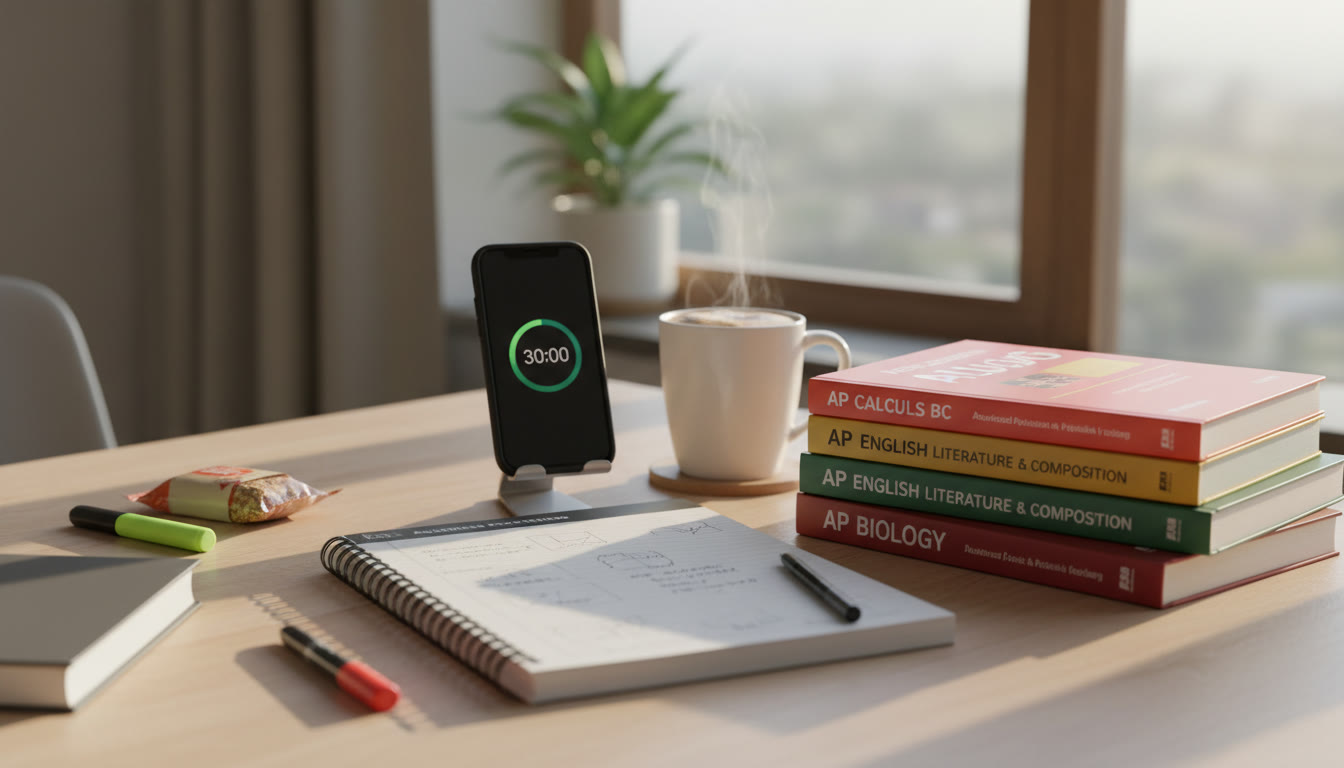Why the 15-30-60 Loop Works: A Friendly Introduction
If you’re serious about scoring well on AP exams, you don’t need magic—just a reliable daily routine. The 15-30-60 Loop is a simple pipeline that mixes short, focused reviews with slightly longer checkpoints so material moves from forgettable to familiar. It borrows from memory science (spaced repetition, retrieval practice) and pairs it with practical routines AP students actually stick to. Think of it as a daily heartbeat for your study life: short pulses, steady rhythm, growing strength.

What the Numbers Mean
The 15-30-60 Loop labels three review lengths that you cycle through regularly. They don’t have to be literal minutes for every activity, but keeping the proportions is the key idea.
- 15 — Micro Review: Quick, daily touchpoints to prime recall and fix small facts, formulas, or vocabulary.
- 30 — Mini Deep-Dive: Slightly longer sessions to practice problems, connect ideas, and apply concepts.
- 60 — Checkpoint Session: Weekly or biweekly extended review that tests synthesis and exam-style performance.
How to Build Your Daily Review Pipeline
Designing a pipeline means choosing what goes into each node (15, 30, 60) and when you do it. The pipeline is flexible: morning or night, before or after class—what matters is regularity and intentional mixing of practice types.
Step 1 — Pick Your Core Content
List the topics you must master for each AP course: key terms, formulas, frameworks, and problem types. Use course outlines from your teacher or the official AP Course Description as your guide. Then break those topics into bite-sized cards or prompts that can be reviewed quickly.
Step 2 — Assign Each Topic to a Loop Slot
Not everything gets equal attention. Use three tiers:
- Tier A (Daily 15): Flash facts, quick definitions, formulas, and short answer prompts you might forget overnight.
- Tier B (Every 2–3 Days 30): Problem sets, conceptual sketching, short practice questions, or a single free-response subsection.
- Tier C (Weekly 60): Full practice sections, timed essays, or mixed-topic reviews combining multiple skills and question formats.
Sample Weekly Pipeline: A Table You Can Copy
Below is a sample pipeline for a student juggling two AP courses. Adjust days and content to fit your exact schedule and testing window.
| Day | 15-Minute Micro Review | 30-Minute Mini Deep-Dive | 60-Minute Checkpoint |
|---|---|---|---|
| Monday | Biology vocab cards + quick diagrams | AP Bio: 2 data-based MCQs practice | — |
| Tuesday | APUSH timeline flash review | APUSH: DBQ outline practice (half essay) | — |
| Wednesday | Formula recall (Physics) | Physics: 3 multi-step problems | — |
| Thursday | Language/Latin roots + vocab | AP Lang: timed rhetorical analysis paragraph | — |
| Friday | Mental walk-through of week’s toughest concept | Mixed practice: one question from each subject | 60-minute checkpoint rotating subjects weekly |
| Saturday | Light recap: quick flash pass | Extra problem set or teacher feedback review | Optional extended practice test every 2–3 weeks |
| Sunday | Plan next week’s Loop topics | Catch-up or rest | Reflection: error log review (60 min) |
Practical Tips for Each Loop Stage
15-Minute Micro Review — Make It Bite-Sized and Delightful
This is where most gains happen because of frequency. Keep it active: quiz yourself aloud, attempt a flash card, sketch a quick diagram, or do a single worked example. Aim for high retrieval and low passive reading.
- Use spaced flashcards with active recall prompts.
- Mix subjects to keep your brain fresh and avoid fatigue.
- Timebox it—15 minutes of intense focus beats 30 minutes of distracted scrolling.
30-Minute Mini Deep-Dive — Solve, Explain, and Connect
Here you stretch beyond recall into application. Solve a group of problems, write a concise explanation of a process, or annotate a practice passage. This is the sweet spot for practicing exam-style skills without burning out.
- Alternate between practice problems and short explanation tasks.
- After each problem, write a 1–2 sentence explanation as if teaching a friend.
- Use AP-style rubrics to self-check or have a tutor review this work.
60-Minute Checkpoint — Simulate, Synthesize, Score
Use weekly 60-minute sessions to simulate a chunk of the exam: a timed MCQ set, one full free-response, or a mixed-topic quiz. Keep an error log and track trends—this is where the pipeline shows you what’s left to fix.
- Time yourself and mimic testing conditions.
- Afterward, spend the last 15–20 minutes reviewing mistakes and updating your flashcards or notes.
- Rotate subjects so each AP course gets regular checkpoint attention.
How to Personalize: Turn the Pipeline Into Your Plan
No two students learn the same way. Personalization means adjusting frequency, intensity, and content focus until the pipeline fits your energy and schedule.
Mapping Effort to Return
Use a simple scale to decide where to focus: 1 = mastered, 2 = shaky, 3 = struggling. Anything marked 2 or 3 moves into Tier A or B sooner. Over time, fewer items will stay at 3—this is how the pipeline compresses your weak spots into quick wins.
When to Shift the Ratios
- If you’re weeks away from the exam: increase 60-minute checkpoints to twice a week and add one longer practice test every weekend.
- If you’re balancing schoolwork: prioritize 15-minute micro reviews daily to keep retention steady with less time.
- During lighter periods: use the freed-up time for deeper 60-minute synthesis sessions or to tutor peers—teaching is a fast path to mastery.
Tools and Habits That Keep the Pipeline Flowing
You don’t need expensive apps, but the right routines and a couple of tools can make the Loop near-automatic.
Daily Tools
- Timer app (Pomodoro-style) to enforce the 15–30–60 rhythm.
- Flashcard system (digital or paper) for daily retrieval practice.
- Error log notebook or spreadsheet for checkpoint analysis.
Weekly Habits
- Plan Sunday: choose which topics will live in each Loop slot for the week.
- Reflect Friday: record progress and adjust the next week’s focus.
- Get external feedback at least every two weeks—ask your teacher or a tutor to check one checkpoint session.
How Sparkl’s Personalized Tutoring Can Plug Into Your Pipeline
Personalized support can make your 30 and 60-minute sessions far more effective. Sparkl’s 1-on-1 guidance fits naturally into the Loop—tutors can help you build tailored study plans, give targeted feedback on checkpoint essays, and provide AI-driven insights to refine which topics belong in your daily 15-minute rounds. If you’re using an external tutor, ask them to align lessons with your Loop schedule so every session yields actionable additions to your flashcards and error log.
Examples: Real Student Routines Using the 15-30-60 Loop
Here are two short, realistic routines so you can see how this fits into busy lives.
Case Study 1 — Maya: AP Biology + AP Calculus AB
Maya studies before school for 15 minutes (bio vocab + calc formula drill). After school she does 30 minutes of targeted practice—alternate days for Bio and Calc. Friday evening is her 60-minute checkpoint, focusing on a full free-response practice for the subject she finds hardest that week. She shares weekly error logs with her Sparkl tutor, who gives a 20-minute review during the tutor session to correct misconceptions and recommend new flashcards.
Case Study 2 — Carlos: APUSH and AP Lang, Busy Senior
Carlos does a 15-minute morning review of timelines or rhetorical devices, fits a 30-minute practice after dinner (alternate DBQ outlines and short rhetorical analyses), and takes a Sunday 60-minute checkpoint to write a full DBQ or timed synthesis essay. He keeps the Loop light during soccer season but ramps up 60-minute work twice weekly in April. His Sparkl tutor provides quick rubrics and clarifies what readers expect on the DBQ, turning checkpoint mistakes into focused revision tasks.
Common Roadblocks and How to Fix Them
Even the best pipeline can break. Here are common problems and practical, no-fluff fixes.
Roadblock: I Missed a Week—Now I’m Behind
Don’t panic. Use a recovery microcycle: three consecutive 15-minute sessions for the top 9 weak topics, then resume normal rhythm. Avoid bingeing long hours—short, frequent recovery beats all-night cramming.
Roadblock: The 15-Minutes Feels Useless
Make it active: replace rereading with retrieval practice. If your 15s are passive, convert them to micro-quizzes, quick written recalls, or a single timed problem solved without notes.
Roadblock: I’m Bored or Burnt Out
Switch mode: swap subjects, work with a study buddy, or replace one 15-minute session with a teaching activity (explain a concept to a friend or record a short voice note summarizing a chapter). Micro-variations revive engagement.
Measuring Progress: Metrics That Actually Mean Something
Numbers are motivating when they reflect real learning. Track these simple metrics weekly in your error log:
- Retention rate on flashcards (percent correct after 1 day, 7 days).
- Average score on 30-minute problem sets.
- Time-to-solution on typical exam problems (how long to reach a correct answer).
- Quality improvements on checkpoint essays (rubric scores or tutor feedback).
Plot these as small charts in a notebook or spreadsheet. Seeing steady, modest gains is often the best motivational fuel.
Exam Month: How to Scale the Loop for Peak Performance
In the final month before exams, shift emphasis toward 60-minute checkpoints while keeping daily 15s as maintenance. Do at least one full-length practice test under exam conditions every 7–10 days, and treat each result as data: which question types keep hurting you? Funnel those into the next week’s 15–30–60 Loop and attack them deliberately.
Why This Pipeline Is More Sustainable Than Marathon Studying
Two truths about exam prep: attention is limited, and forgetting is normal. The 15-30-60 Loop respects both. By spacing reviews and alternating intensity, it preserves energy, reduces anxiety, and converts practice into long-term retention—so the knowledge you build sticks when it matters most.
Final Thoughts: Start Small, Iterate Often
Start with one subject and roll the Loop into your week. Track outcomes, tweak the proportions, and expand as the routine becomes habit. With consistent small actions—daily 15s, regular 30s, and weekly 60s—you’ll transform scattered study into a steady, confident march toward AP success.
And one last pro tip: pair your pipeline with targeted support when you need it. Short, focused sessions with an expert tutor—like Sparkl’s 1-on-1 guidance—can shorten the feedback loop, turn weaknesses into strengths, and make every 15, 30, and 60 minute count.

Quick Starter Checklist: Your First Week
- Create a topic list for each AP subject you’re taking.
- Decide which items are Tier A, B, and C.
- Set three daily alarms or calendar events for your 15, 30, and 60-minute blocks.
- Build or start your flashcard set and error log.
- Schedule one 30–45 minute session with a Sparkl tutor or a teacher for targeted feedback on a checkpoint session.
Wrap-Up: The Habit That Outperforms Cramming
AP preparation is a marathon of steady build-up, not a sprint. The 15-30-60 Loop gives you a repeatable, human-friendly structure that honors how memory and focus actually work. Keep it flexible, track what matters, get feedback when you need it, and remember: consistency plus smart review beats last-minute intensity almost every time. Start today, adjust as you learn, and let each loop make you better than the last.
























No Comments
Leave a comment Cancel